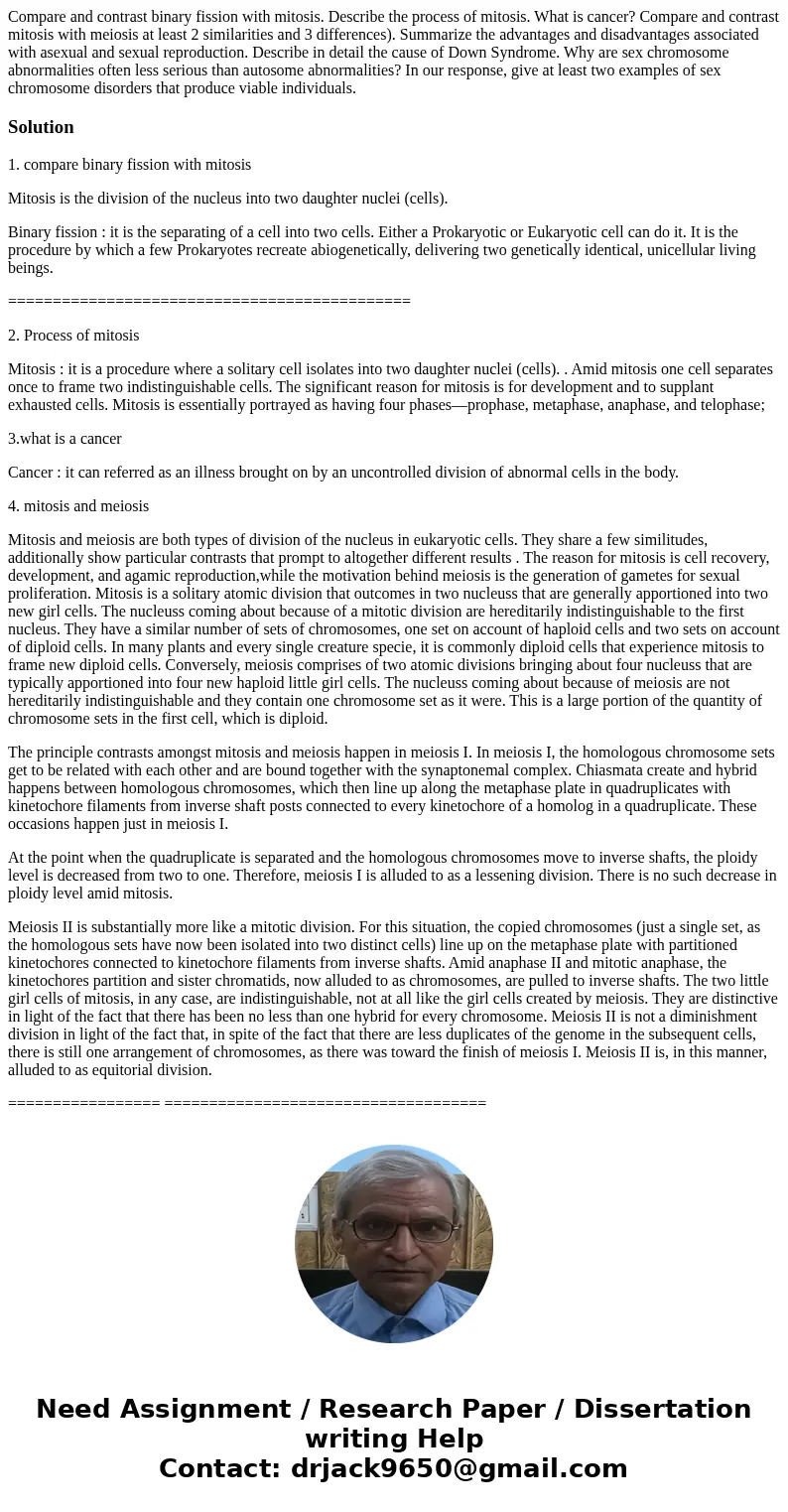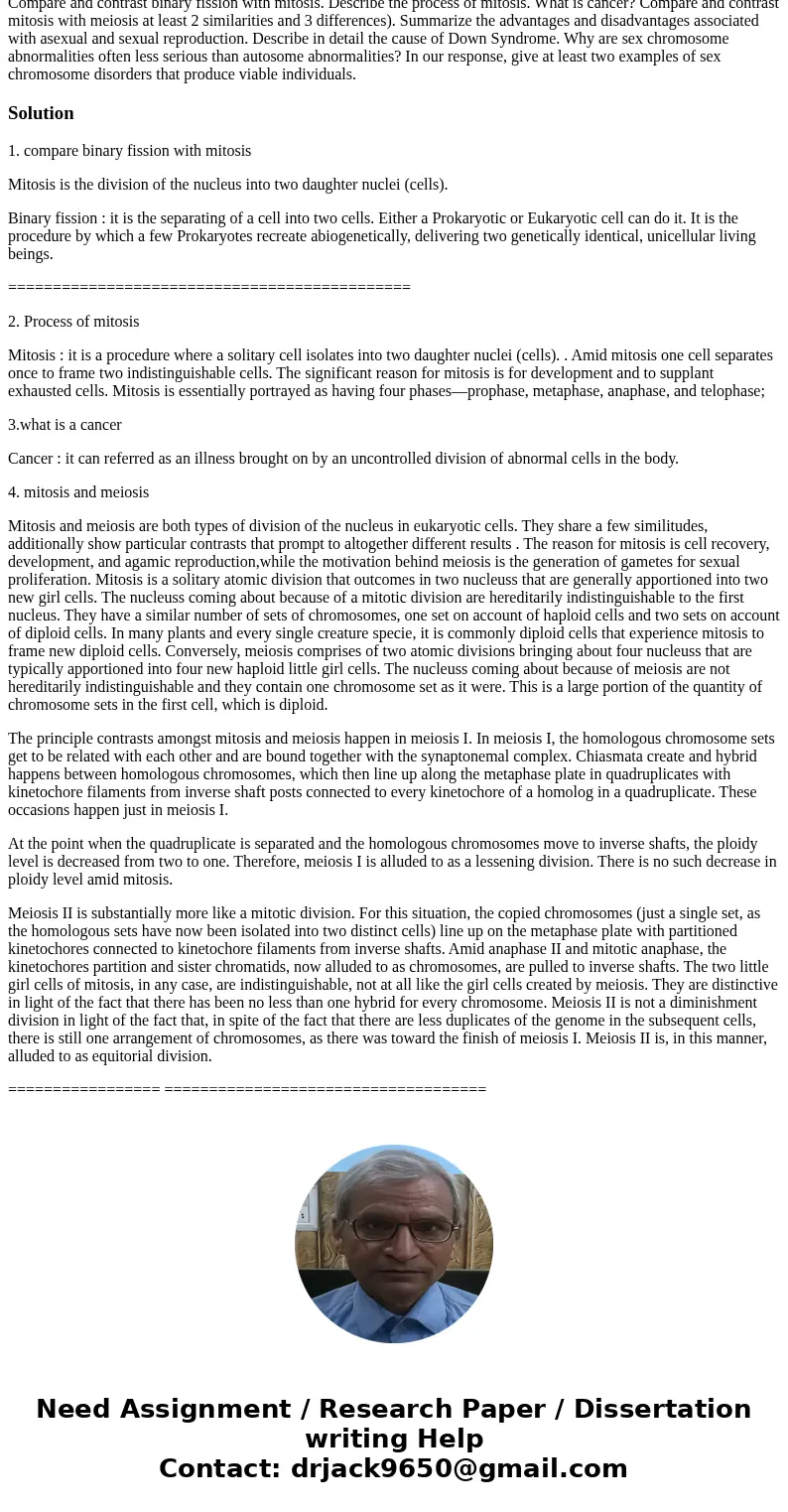Compare and contrast binary fission with mitosis Describe th
Solution
1. compare binary fission with mitosis
Mitosis is the division of the nucleus into two daughter nuclei (cells).
Binary fission : it is the separating of a cell into two cells. Either a Prokaryotic or Eukaryotic cell can do it. It is the procedure by which a few Prokaryotes recreate abiogenetically, delivering two genetically identical, unicellular living beings.
=============================================
2. Process of mitosis
Mitosis : it is a procedure where a solitary cell isolates into two daughter nuclei (cells). . Amid mitosis one cell separates once to frame two indistinguishable cells. The significant reason for mitosis is for development and to supplant exhausted cells. Mitosis is essentially portrayed as having four phases—prophase, metaphase, anaphase, and telophase;
3.what is a cancer
Cancer : it can referred as an illness brought on by an uncontrolled division of abnormal cells in the body.
4. mitosis and meiosis
Mitosis and meiosis are both types of division of the nucleus in eukaryotic cells. They share a few similitudes, additionally show particular contrasts that prompt to altogether different results . The reason for mitosis is cell recovery, development, and agamic reproduction,while the motivation behind meiosis is the generation of gametes for sexual proliferation. Mitosis is a solitary atomic division that outcomes in two nucleuss that are generally apportioned into two new girl cells. The nucleuss coming about because of a mitotic division are hereditarily indistinguishable to the first nucleus. They have a similar number of sets of chromosomes, one set on account of haploid cells and two sets on account of diploid cells. In many plants and every single creature specie, it is commonly diploid cells that experience mitosis to frame new diploid cells. Conversely, meiosis comprises of two atomic divisions bringing about four nucleuss that are typically apportioned into four new haploid little girl cells. The nucleuss coming about because of meiosis are not hereditarily indistinguishable and they contain one chromosome set as it were. This is a large portion of the quantity of chromosome sets in the first cell, which is diploid.
The principle contrasts amongst mitosis and meiosis happen in meiosis I. In meiosis I, the homologous chromosome sets get to be related with each other and are bound together with the synaptonemal complex. Chiasmata create and hybrid happens between homologous chromosomes, which then line up along the metaphase plate in quadruplicates with kinetochore filaments from inverse shaft posts connected to every kinetochore of a homolog in a quadruplicate. These occasions happen just in meiosis I.
At the point when the quadruplicate is separated and the homologous chromosomes move to inverse shafts, the ploidy level is decreased from two to one. Therefore, meiosis I is alluded to as a lessening division. There is no such decrease in ploidy level amid mitosis.
Meiosis II is substantially more like a mitotic division. For this situation, the copied chromosomes (just a single set, as the homologous sets have now been isolated into two distinct cells) line up on the metaphase plate with partitioned kinetochores connected to kinetochore filaments from inverse shafts. Amid anaphase II and mitotic anaphase, the kinetochores partition and sister chromatids, now alluded to as chromosomes, are pulled to inverse shafts. The two little girl cells of mitosis, in any case, are indistinguishable, not at all like the girl cells created by meiosis. They are distinctive in light of the fact that there has been no less than one hybrid for every chromosome. Meiosis II is not a diminishment division in light of the fact that, in spite of the fact that there are less duplicates of the genome in the subsequent cells, there is still one arrangement of chromosomes, as there was toward the finish of meiosis I. Meiosis II is, in this manner, alluded to as equitorial division.
================= ====================================


 Homework Sourse
Homework Sourse